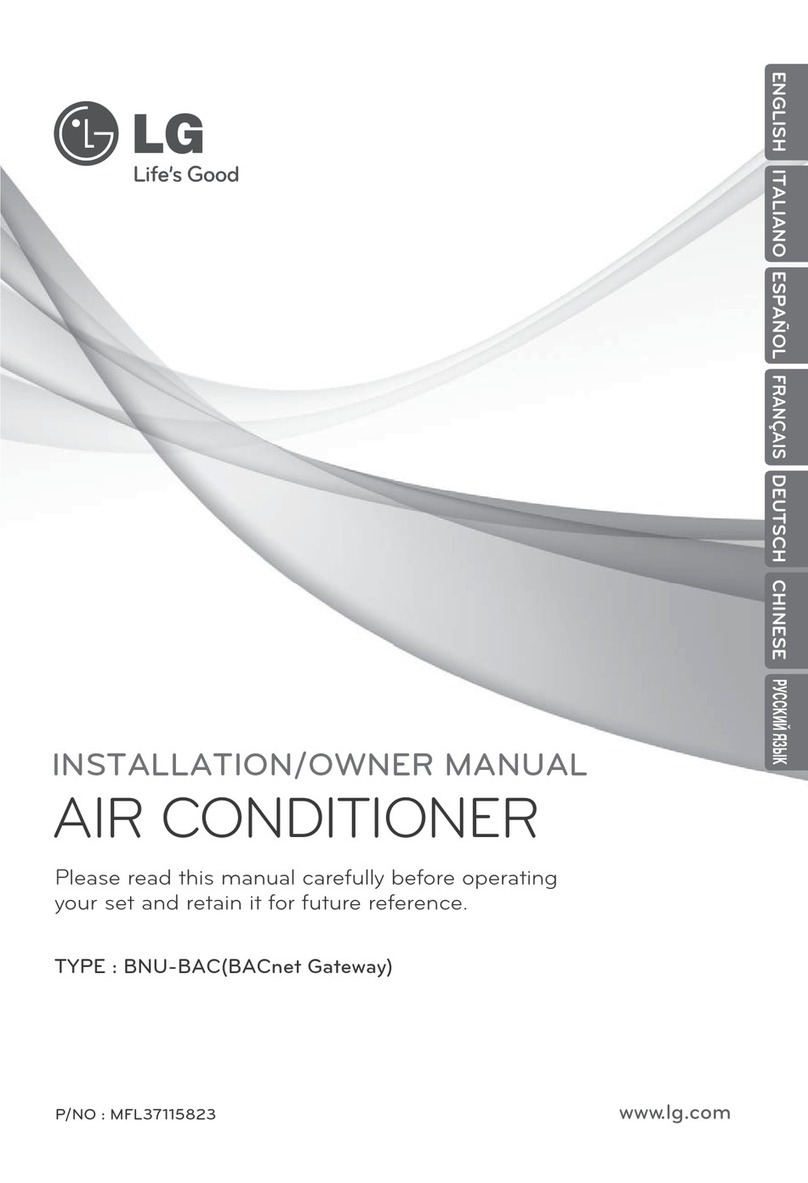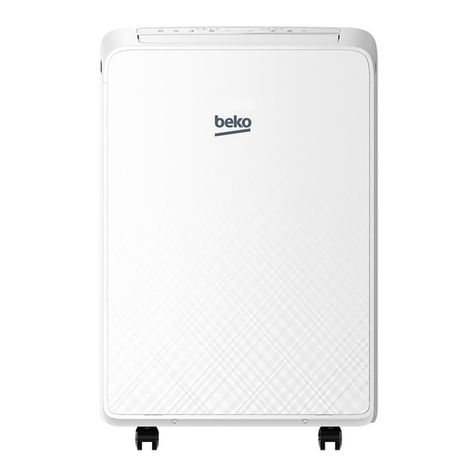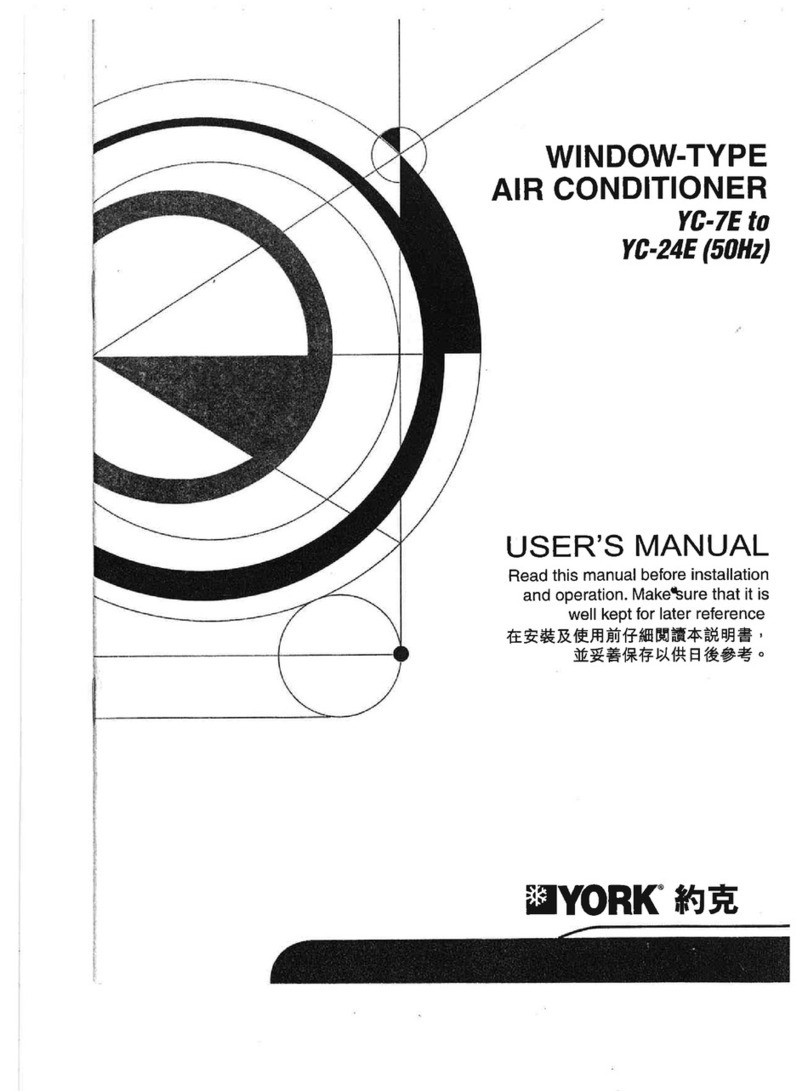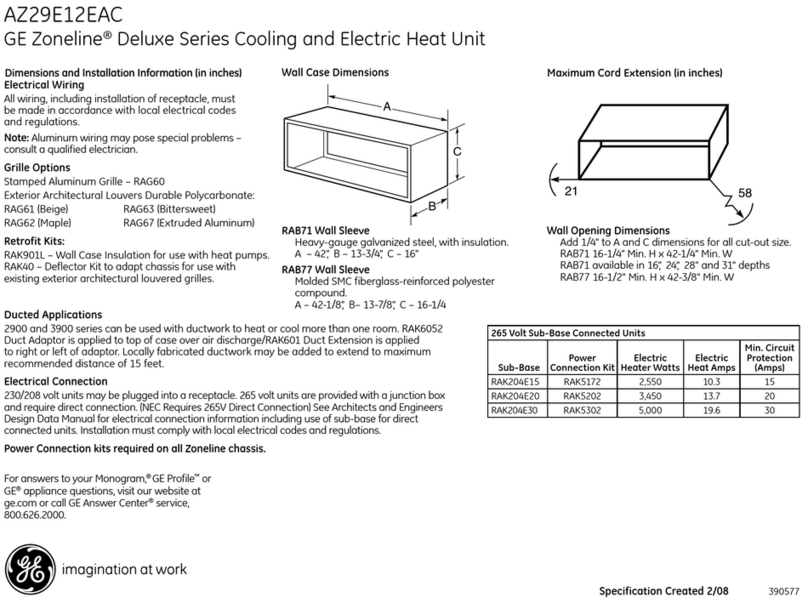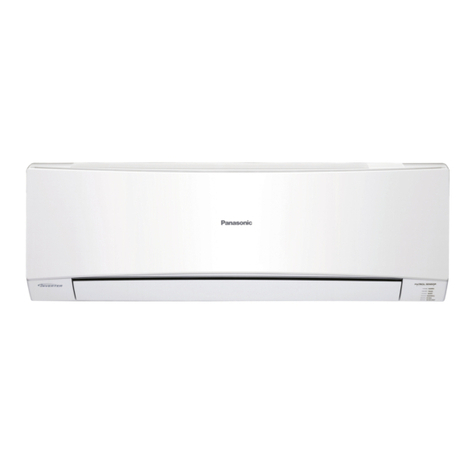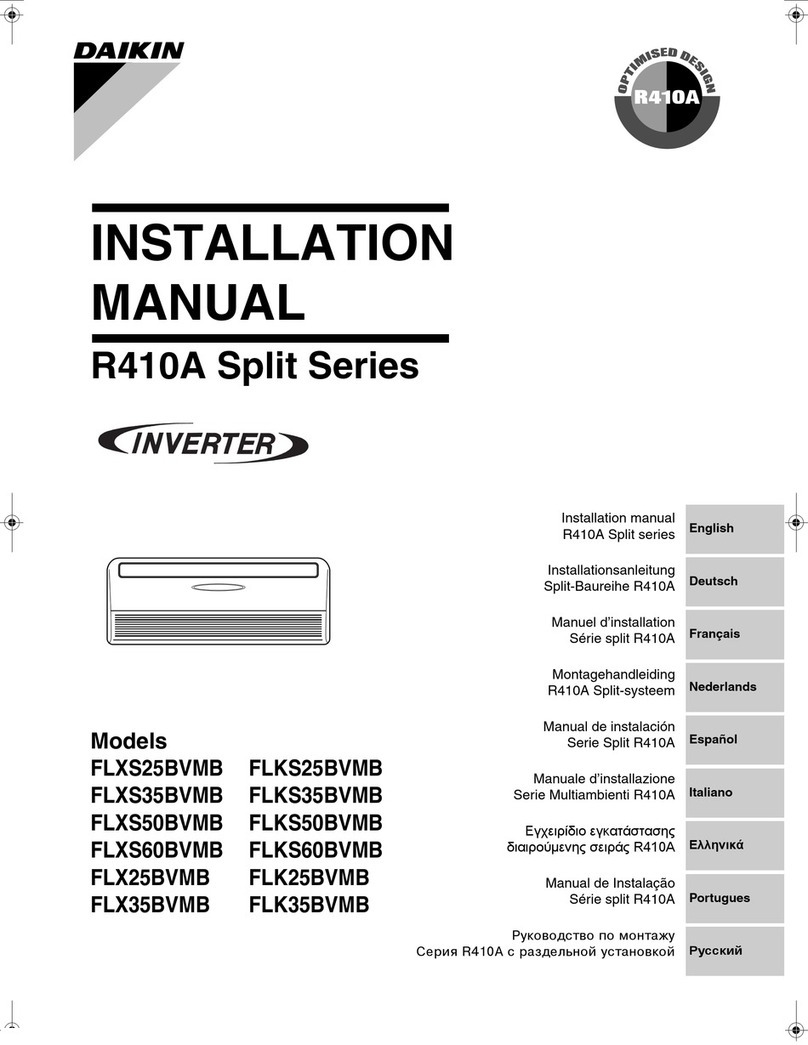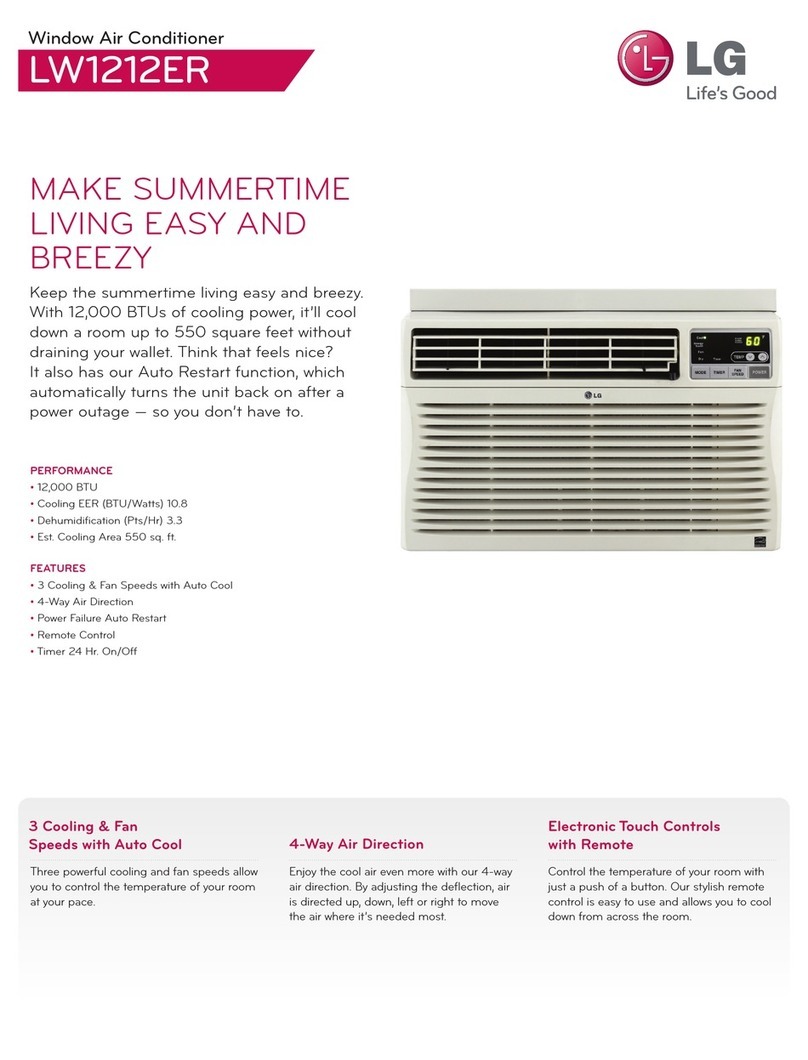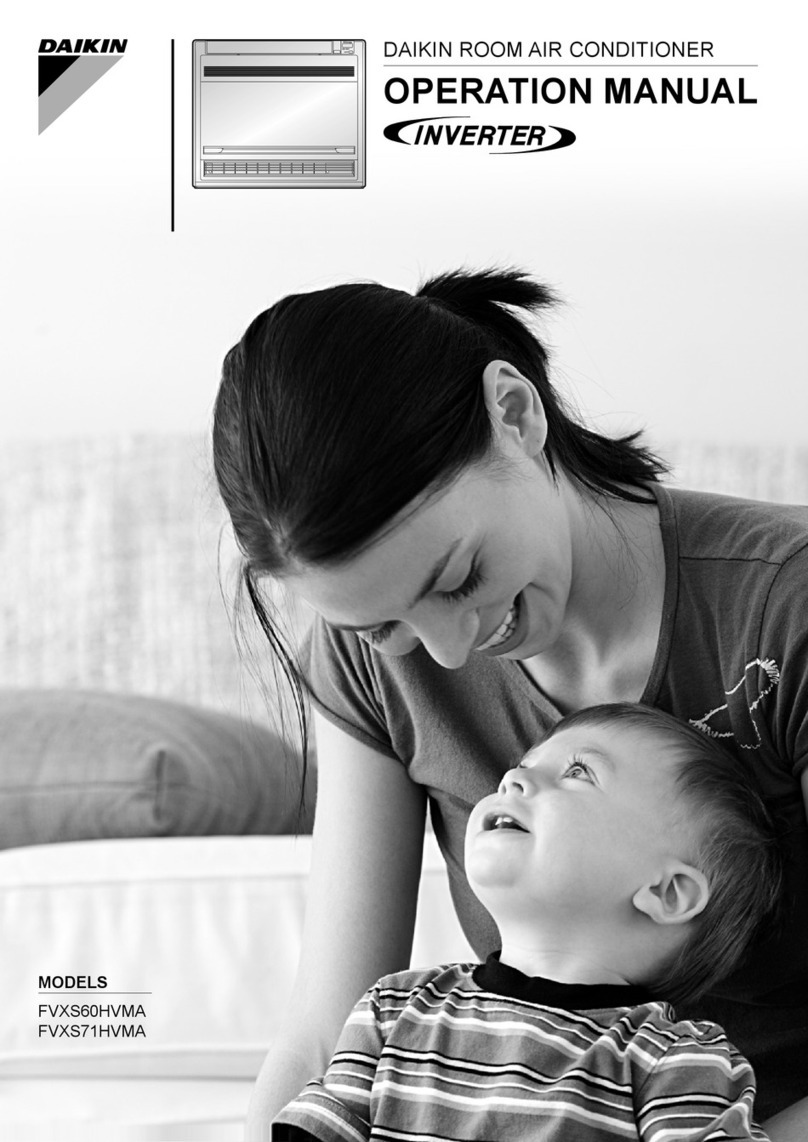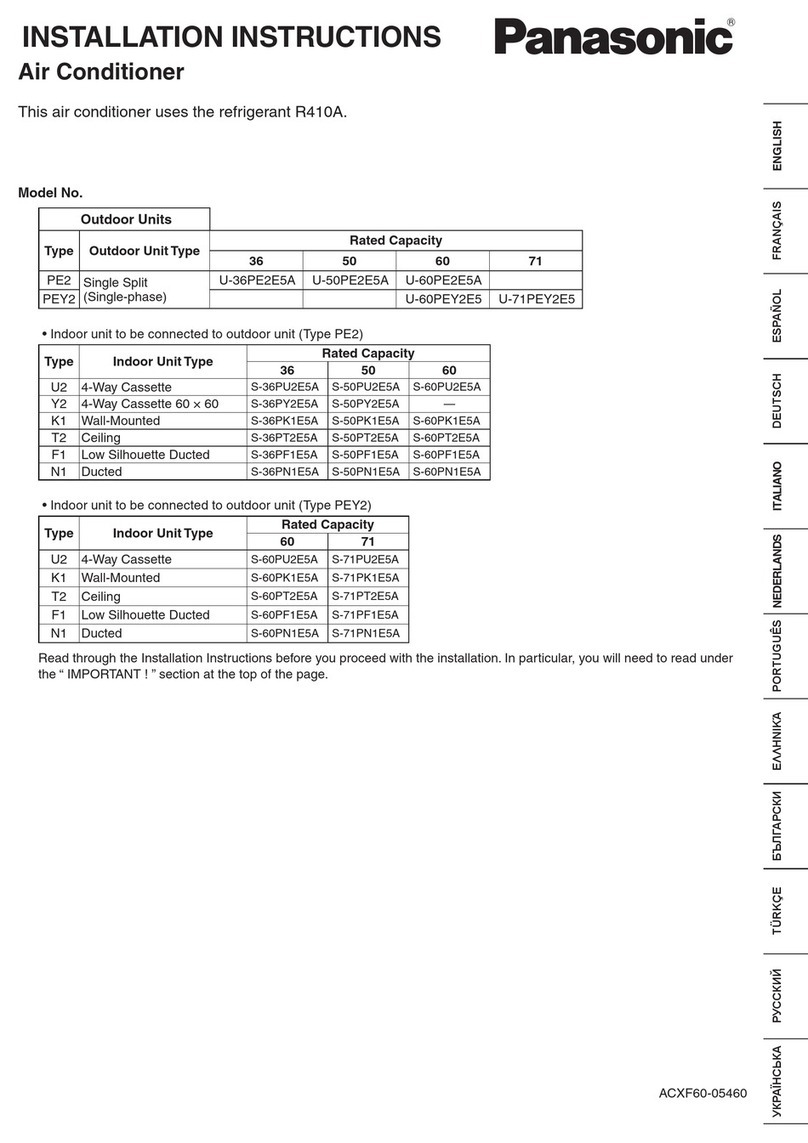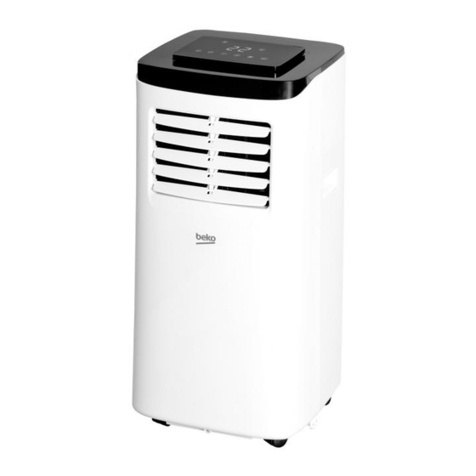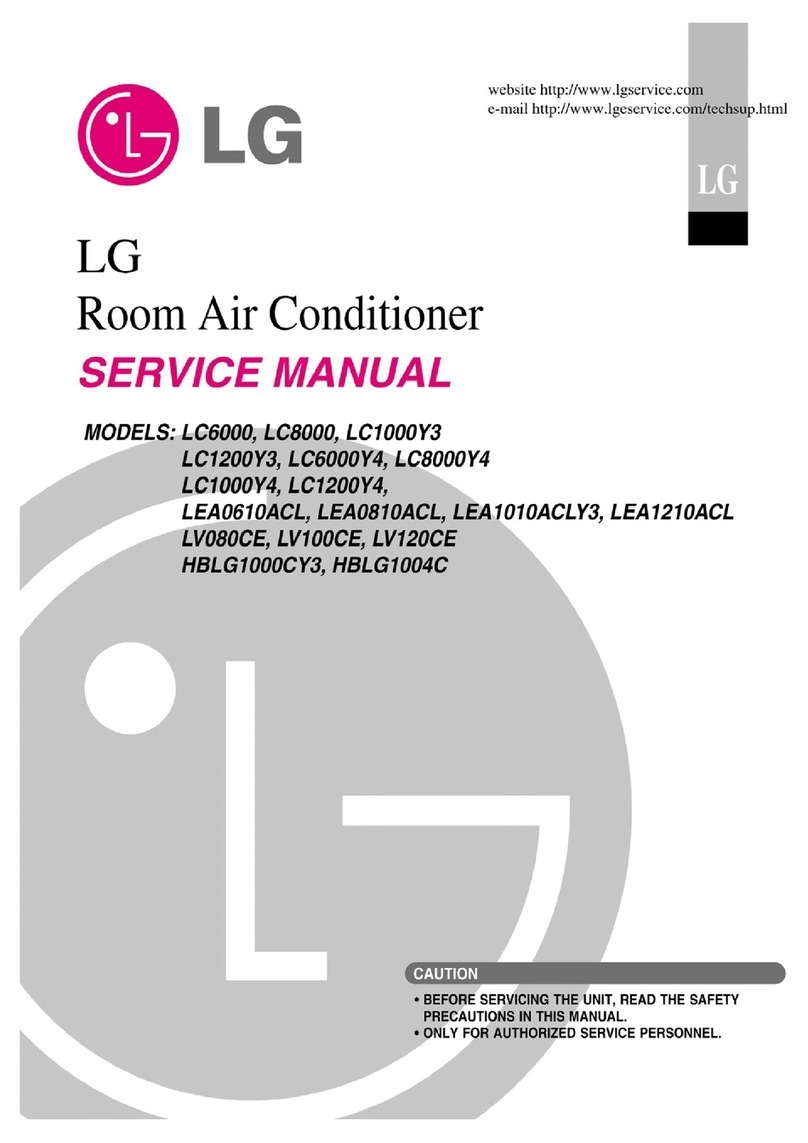Grandaire W4A7T User manual

Installation Instructions
NOTE: Read the entire instruction manual before starting the installation.
SAFETY CONSIDERATIONS
Improper installation, adjustment, alteration, service, maintenance, or
use can cause explosion, fire, electrical shock, or other conditions which
may cause death, personal injury, or property damage. Consult a
qualified installer, service agency, or your distributor or branch for
information or assistance. The qualified installer or agency must use
factory-authorized kits or accessories when modifying this product.
Refer to the individual instructions packaged with the kits or accessories
when installing.
Follow all safety codes. Wear safety glasses, protective clothing, and
work gloves. Use quenching cloth for brazing operations. Have fire
extinguisher available. Read these instructions thoroughly and follow all
warnings or cautions included in literature and attached to the unit.
Consult local building codes and current editions of the National
Electrical Code (NEC) NFPA 70. In Canada, refer to current editions of
the Canadian Electrical Code CSA 22.1.
Recognize safety information. This is the safety-alert symbol . When
you see this symbol on the unit and in instructions or manuals, be alert to
the potential for personal injury. Understand these signal words;
DANGER, WARNING, and CAUTION. These words are used with the
safety-alert symbol. DANGER identifies the most serious hazards
which will result in severe personal injury or death. WARNING
signifies hazards which could result in personal injury or death.
CAUTION is used to identify unsafe practices which would result in
minor personal injury or product and property damage. NOTE is used to
highlight suggestions which will result in enhanced installation,
reliability, or operation.
Installation Recommendations
NOTE: In some cases noise in the living area has been traced to gas
pulsations from improper installation of equipment.
1. Locate unit away from windows, patios, decks, etc. where unit
operation sound may disturb customer.
2. Ensure that vapor and liquid tube diameters are appropriate for unit
capacity.
3. Run refrigerant tubes as directly as possible by avoiding
unnecessary turns and bends.
4. Leave some slack between structure and unit to absorb vibration.
5. When passing refrigerant tubes through the wall, seal opening with
RTV or other pliable silicon-based caulk. (See Fig. 1.)
6. Avoid direct tubing contact with water pipes, duct work, floor
joists, wall studs, floors, and walls.
7. Do not suspend refrigerant tubing from joists and studs with a rigid
wire or strap which comes in direct contact with tubing.(See Fig. 1.)
8. Ensure that tubing insulation is pliable and completely surrounds
vapor tube.
9. When necessary, use hanger straps which are 1 in. (25.4 mm) wide
and conform to shape of tubing insulation. (See Fig. 1.)
10. Isolate hanger straps from insulation by using metal sleeves bent to
conform to shape of insulation.
A07588
Fig. 1 – Connecting Tubing Installation
The outdoor unit contains system refrigerant charge for operation with
AHRI rated indoor unit when connected by 15 ft. (4.57 m) of
field-supplied or factory accessory tubing. For proper unit operation,
check refrigerant charge using charging information located on control
box cover and/or in the Check Charge section of this instruction.
IMPORTANT: Maximum liquid-line size is 3/8-in. OD for all
residential applications including long line.
IMPORTANT: Always install the factory-supplied liquid-line filter
drier. If replacing the filter drier, refer to Product Data Digest for
appropriate part number. Obtain replacement filter driers from your
distributor or branch.
W4A7T
SPLIT-SYSTEM 2-STAGE AIR CONDITIONER
WITH R-410A REFRIGERANT
2 - 5 TONS
WARNING
!
ELECTRICAL SHOCK HAZARD
Failure to follow this warning could result in personal injury or death.
Before installing, modifying, or servicing system, main electrical
disconnect switch must be in the OFF position. There may be more than
1 disconnect switch. Lock out and tag switch with a suitable warning
label.
WARNING
!
EXPLOSION HAZARD
Failure to follow this warning could result in
death, serious personal injury, death, and/or
property damage.
Never use air or any gas containing oxygen for
leak testing or operating refrigerant
compressors. Never allow compressor suction
pressure to operate in a vacuum with service
valves closed. See Service Manual for
pump-down instructions.
“

W4A7T: Installation Instructions
Manufacturer reserves the right to change, at any time, specifications and designs without notice and without obligations.
2
Installation
IMPORTANT: All split system and packaged air conditioners must be
installed pursuant to applicable regional efficiency standards issued by
the Department of Energy.
Check Equipment and Job Site
UNPACK UNIT
Move to final location. Remove carton taking care not to damage unit.
Inspect Equipment
File claim with shipping company prior to installation if shipment is
damaged or incomplete. Locate unit rating plate on unit corner panel. It
contains information needed to properly install unit. Check rating plate
to be sure unit matches job specifications.
Install on a Solid, Level Mounting Pad
If conditions or local codes require the unit be attached to pad, tie down
bolts should be used and fastened through knockouts provided in unit
base pan. Refer to unit mounting pattern in Fig. 2 to determine base pan
size and knockout hole location.
For hurricane tie downs, contact local distributor for details and PE
(Professional Engineer) certification, if required by local authorities.
On rooftop applications, mount on level platform or frame. Place unit
above a load-bearing wall and isolate unit and tubing set from structure.
Arrange supporting members to adequately support unit and minimize
transmission of vibration to building. Consult local codes governing
rooftop applications.
Roof mounted units exposed to winds may require wind baffles. Consult
the Application Guideline and Service Manual - Residential Split
System Air Conditioners and Heat Pumps for wind baffle construction.
NOTE: Unit must be level to within ±2° (±3/8 in./ft,±9.5 mm/m.) per
compressor manufacturer specifications.
Clearance Requirements
When installing, allow sufficient space for airflow clearance, wiring,
refrigerant piping, and service. Allow 24 in. (609.6 mm) clearance to
service end of unit and 48 in. (1219.2 mm) (above unit. For proper
airflow, a 6-in. (152.4 mm) clearance on 1 side of unit and 12-in. (304.8
mm) on all remaining sides must be maintained. Maintain a distance of
24 in. (609.6 mm) between units. Position so water, snow, or ice from
roof or eaves cannot fall directly on unit.
On rooftop applications, locate unit at least 6 in. (152.4 mm) above roof
surface.
Make Piping Connections
A05177
Fig. 2 – Tiedown Knockout Locations
Outdoor units may be connected to indoor section using accessory
tubing package or field-supplied refrigerant grade tubing of correct size
and condition. Rated tubing diameters shown in Table 1 are
recommended up to 80 ft. (24.38 m). See Product Data for acceptable
alternate vapor diameters and associated capacity losses. For tubing
requirements beyond 80 ft. (24.38 m), substantial capacity and
performance losses can occur. Following the recommendations in the
Longline Guideline will reduce these losses. Refer to Table 1 for field
tubing diameters. Refer to Table 2 for accessory requirements.
There are no buried-line applications greater than 36-in. (914.4 mm)
allowed.
If refrigerant tubes or indoor coil are exposed to atmosphere, they must
be evacuated to 500 microns to eliminate contamination and moisture in
the system.
Outdoor Unit Connected to Factory Approved Indoor
Unit
Outdoor unit contains correct system refrigerant charge for operation
with factory approved AHRI rated indoor unit when connected by 15 ft.
(4.57 m) of field-supplied or factory-accessory tubing, and factory
supplied filter drier. Check refrigerant charge for maximum efficiency.
Refrigerant Tubing Connection Outdoor
Connect vapor and liquid tubes to fittings on vapor and liquid service
valves (see Table 1.) Use refrigerant grade tubing
Sweat Connection
CAUTION
!
CUT HAZARD
Failure to follow this caution may result in personal injury.
Sheet metal parts may have sharp edges or burrs. Use care and wear
appropriate protective clothing and gloves when handling parts.
WARNING
!
PERSONAL INJURY AND ENVIRONMENTAL HAZARD
Failure to follow this warning could result in personal injury or death.
Relieve pressure and recover all refrigerant before system repair or
final unit disposal. Use all service ports and open all flow-control
devices, including solenoid valves.
Federal regulations require that you do not vent refrigerant to the
atmosphere. Recover during system repair or final unit disposal.
CAUTION
!
UNIT DAMAGE HAZARD
Failure to follow this caution may result in equipment damage or
improper operation.
If ANY refrigerant tubing is buried, provide a 6-in (152.4 mm) vertical
rise at service valve. Refrigerant tubing lengths up to 36-in (914.4 mm)
may be buried without further special consideration. Do not bury lines
more than 36-in. (914.4 mm).
UNIT BASE PAN
Dimension in.
(mm)
TIEDOWN KNOCKOUT LOCATIONS in. (mm)
ABC
31–1/2 X 31–1/2
(800 X 800) 9–1/8 (231.8) 6–9/16 (166.7) 24–11/16
(627.1)
35 X 35
(889 X 889) 9–1/8 (231.8) 6–9/16 (166.7) 28–7/16
(722.3)

W4A7T: Installation Instructions
Manufacturer reserves the right to change, at any time, specifications and designs without notice and without obligations.
3
Use refrigeration grade tubing. Service valves are closed from factory
and ready for brazing. After wrapping service valve with a wet cloth,
braze sweat connections using industry accepted methods and materials.
Consult local code requirements. Refrigerant tubing and indoor coil are
now ready for leak testing. This check should include all field and
factory joints
* Units are rated with 25 ft. (7.6 m) of lineset. See Product Data sheet for performance data
when using different size and length linesets.
Notes:
1.Do not apply capillary tube or fixed orifice indoor coils to these units.
2.For Tubing Set lengths between 80 and 200 ft. (24.38 and 60.96 m) horizontal or 35 ft.
(10.7 m) vertical differential 250 ft. (76.2 m) Total Equivalent Length), refer to the
Residential Piping and Longline Guideline -Air Conditioners and Heat Pumps using
R-410A refrigerant.
Install Liquid-Line Filter Drier Indoor
Refer to Fig. 3 and install filter drier as follows:
1. Braze 5-in. liquid tube to the indoor coil.
2. Wrap filter drier with damp cloth.
3. Braze filter drier to above 5-in. (127 mm) liquid tube. Flow arrow
must point towards indoor coil.
4. Connect and braze liquid refrigerant tube to the filter drier.
A05178
Fig. 3 – Liquid Line Filter Drier
Evacuate Refrigerant Tubing and Indoor Coil
Refrigerant tubes and indoor coil should be evacuated using the
recommended deep vacuum method of 500 microns. The alternate triple
evacuation method may be used (see triple evacuation procedure in
service manual). Always break a vacuum with dry nitrogen.
Deep Vacuum Method
The deep vacuum method requires a vacuum pump capable of pulling a
vacuum of 500 microns and a vacuum gage capable of accurately
measuring this vacuum depth. The deep vacuum method is the most
positive way of assuring a system is free of air and liquid water. A tight
dry system will hold a vacuum of 1000 microns after approximately 7
minutes. See Fig. 4.
A95424
Fig. 4 – Deep Vacuum Graph
Final Tubing Check
IMPORTANT: Check to be certain factory tubing on both indoor and
outdoor unit has not shifted during shipment. Ensure tubes are not
rubbing against each other or any sheet metal or wires. Pay close
attention to feeder tubes, making sure wire ties on feeder tubes are
secure and tight.
CAUTION
!
UNIT DAMAGE HAZARD
Failure to follow this caution may result in equipment damage or
improper operation.
Service valves must be wrapped in a heat-sinking material such as a wet
cloth while brazing.
CAUTION
!
BURN HAZARD
Failure to follow this Caution may result in personal injury.
Components will be HOT after brazing. Wear appropriate personal
protective equipment and allow to cool before handling parts and
equipment
Table 1 – Refrigerant Connections and Recommended Liquid and
Vaport Tube Diameters
UNIT SIZE
(SERIES)
LIQUID RATED VAPOR*
Connection
& Max. Tube
Diameter
Connection
Diameter
Tube
Diameter
24 3/8 3/4 3/4
36 3/8 7/8 7/8
48 3/8 7/8 1-1/8
60 3/8 7/8 1-1/8
CAUTION
!
UNIT DAMAGE HAZARD
Failure to follow this caution may result in equipment damage or
improper operation.
1. Installation of filter drier in liquid line is required.
2. Filter drier must be wrapped in a heat-sinking material such as a
wet cloth while brazing.
CAUTION
!
UNIT DAMAGE HAZARD
Failure to follow this caution may result in equipment damage or
improper operation.
Never use the system compressor as a vacuum pump.
500
MINUTES
01234 56 7
1000
1500
LEAK IN
SYSTEM
VACUUM TIGHT
TOO WET
TIGHT
DRY SYSTEM
2000
MICRONS
2500
3000
3500
4000
4500
5000

W4A7T: Installation Instructions
Manufacturer reserves the right to change, at any time, specifications and designs without notice and without obligations.
4
* For tubing line sets between 80 and 200 ft. (24.38 and 60.96 m) and/or 35 ft. (10.7 m) vertical differential, refer to Residential Piping and Longline Guideline.
Make Electrical Connections
Be sure field wiring complies with local and national fire, safety, and
electrical codes, and voltage to system is within limits shown on unit
rating plate. Contact local power company for correction of improper
voltage. See unit rating plate for recommended circuit protection device.
NOTE: Operation of unit on improper line voltage constitutes abuse
and could affect unit reliability. See unit rating plate. Do not install unit
in system where voltage may fluctuate above or below permissible
limits.
NOTE: Use copper wire only between disconnect switch and unit.
NOTE: Install branch circuit disconnect of adequate size per NEC to
handle unit starting current. Locate disconnect within sight from and
readily accessible from unit, per Section 440-14 of NEC.
Route Ground and Power Wires
Remove access panel to gain access to unit wiring. Extend wires from
disconnect through power wiring hole provided and into unit control
box.
Connect Ground and Power Wires
Connect ground wire to ground connection in control box for safety.
Connect power wiring to contactor as shown in Fig. 5.
A94025
Fig. 5 – Line Power Connections
Connect Control Wiring
Route 24-v control wires through control wiring grommet and connect
leads to control wiring (See Fig. 7). Refer to Installation Instructions
packaged with thermostat.
Use No. 18 AWG color-coded, insulated (35°C minimum) wire. If
thermostat is located more than 100 ft. (30.48 m) from unit, as measured
along the control voltage wires, use No. 16 AWG color-coded wire to
avoid excessive voltage drop.
All wiring must be NEC Class 2 and must be separated from incoming
power leads.
Use furnace transformer, fan coil transformer, or accessory transformer
for control power, 24v/40va minimum.
NOTE: Use of available 24v accessories may exceed the minimum 40va
power requirement. Determine total transformer loading and increase
the transformer capacity or split the load with an accessory transformer
as required.
Final Wiring Check
IMPORTANT: Check factory wiring and field wire connections to
ensure terminations are secured properly. Check wire routing to ensure
wires are not in contact with tubing, sheet metal, etc.
Compressor Crankcase Heater
When equipped with a crankcase heater, furnish power to heater a
minimum of 24 hr before starting unit. To furnish power to heater only,
set thermostat to OFF and close electrical disconnect to outdoor unit.
A crankcase heater is required if refrigerant tubing is longer than 80 ft.
(24.38 m). Refer to the Application Guideline and Service Manual
Longline Section-Residential Split-System Air Conditioners and Heat
Pumps.
Table 2 – Accessory Usage
Accessory
Required for Low Ambient
Cooling Applications
(Below 55°F / 12.8°C)
Required for Long Line
Applications*
Required for Sea Coast
Applications
(within 2 miles/3.2 km)
Compressor Start Assist Capacitor and Relay Yes Yes No
Crankcase Heater Yes (standard on some units) Yes (standard on some units) No
Evaporator Freeze Thermostat Yes No No
Hard Shutoff TXV
Yes
(standard w/factory approved
indoor unit)
Yes
(standard w/factory approved
indoor unit)
Yes
(standard w/factory approved
indoor unit)
Liquid Line Solenoid Valve No See Residential Piping
and Long Line Guideline No
Low-Ambient Pressure Switch Yes No No
Support Feet Recommended No Recommended
Winter Start Control Yes No No
WARNING
!
ELECTRICAL SHOCK HAZARD
Failure to follow this warning could result in personal injury or death.
The unit cabinet must have an uninterrupted or unbroken ground to
minimize personal injury if an electrical fault should occur. The ground
may consist of electrical wire or metal conduit when installed in
accordance with existing electrical codes.

W4A7T: Installation Instructions
Manufacturer reserves the right to change, at any time, specifications and designs without notice and without obligations.
5
A09276 A09277
Fig. 6 – Thermidistat Wiring with 2-Stage R-410A refrigerant Air Conditioner
A09278 A09279
Fig. 7 – Generic Wiring Diagrams
(See thermostat Installation Instruction for specific unit combinations)
A09306
Thermidistat w/Variable Speed Fan Coil
& 2-Stage Air Conditioner
Thermidistat w/Variable Speed Furnace
& 2-Stage Air Conditioner
Single-Stage Furnace with 2-Stage Air Conditioner 2-Stage Thermostat with Single-Stage Furnace and
2-Stage Air Conditioner

W4A7T: Installation Instructions
Manufacturer reserves the right to change, at any time, specifications and designs without notice and without obligations.
6
Airflow Selections (ECM Furnaces)
The ECM Furnaces provide blower operation to match the capacities of
the compressor during high and low stage cooling operation. Tap
selections on the furnace control board enable the installing technician to
select the proper airflows for each stage of cooling. Below is a brief
summary of the furnace airflow configurations
1. The Y2 call for high stage cooling energizes the “Cool” tap on the
control board. The grey wire from cool tap is connected to tap 5 on
the motor. Refer to the furnace Product Data to find the
corresponding airflow. If the airflow setting for high cooling needs
to be switched from tap 5 to a different tap, jumper a connection
from the cool tap to the desired tap so that the Y2 signal is
communicated via the cool tap to the desired speed tap.
2. The Y1 call for low stage cooling energizes the “Fan” tap on the
control board. The red wire from the fan tap is connected to tap 1 on
the motor. Refer to the furnace Product Data to find the
corresponding airflow. If the airflow setting for low cooling needs
to be switched from tap 1 to a different tap, jumper a connection
from the Fan tap to the desired tap so that the Y1 signal is
communicated via the Fan tap to the desired speed tap. The Y1
setting will also govern the continuous fan airflow for the furnace.
Refer to the literature for the furnace for further details.
Airflow Selection for Variable Speed Furnaces
The variable speed furnaces provide blower operation to match the
capacities of the compressor during high and low stage cooling
operation. The furnace control board allows the installing technician to
select the proper airflows for each stage of cooling. Below is a summary
of required adjustments. See furnace installation instructions for more
details:
1. Turn SW1--5 ON for 400 CFM/ton airflow or OFF for 350
CFM/ton airflow. Factory default is OFF.
2. The A/C DIP switch setting determines airflow during high stage
cooling operation. Select the A/C DIP switch setting corresponding
to the available airflow shown in the furnace Installation
Instructions that most closely matches the required airflow shown
in the air conditioning Product Data for HIGH speed.
3. The CF DIP switch setting determines airflow during low stage
cooling operation. Select the CF DIP switch setting corresponding
to the available airflow shown in the furnace installation
instructions that most closely matches the required airflow shown
in the air conditioning Product Data for LOW speed. If a higher or
lower continuous fan speed is desired, the continuous fan speed can
be changed using the fan switch on the thermostat. Refer to the
furnace Installation Instructions for details of how to use this
feature.
Airflow Selection for FV4C Fan Coils
The FV4C provides high- and low-stage blower operation to match the
capacities of the compressor at high- and low-stage.
To select recommended airflow, refer to the FV4C Installation
Instructions. The FV4C utilizes a control board that allows the installing
technician to select proper airflows. This fan coil has an adjustable
blower-off delay factory set at 90 sec. for high- and low-stage blower
operation.
Install Electrical Accessories
Refer to the individual instructions packaged with kits or accessories
when installing.
Start-Up
Follow these steps to properly start up the system:
1. After system is evacuated, fully back seat (open) liquid and vapor
service valves.
2. Unit is shipped with valve stem(s) front seated (closed) and caps
installed. Replace stem caps after system is opened to refrigerant
flow (back seated). Replace caps finger-tight and tighten with
wrench an additional 1/12 turn.
3. Close electrical disconnects to energize system.
4. Set room thermostat at desired temperature. Ensure that set point is
below indoor ambient temperature and is set low enough to
energize high stage. In order to start the system in high stage, refer
to the literature for the installed thermostat and adjust the set point
so that the differential between the room temperature and the set
temperature energizes Y2.
5. Set room thermostat to COOL and fan control to ON or AUTO
mode, as desired.
6. Operate unit for 15 minutes. Verify system refrigerant charge by
measuring the sub-cooling and comparing with the published
sub-cool on the rating plate.
System Function And Sequence Of Operation
This model utilizes a 2-stage cooling indoor thermostat. With a call for
first stage cooling, the outdoor fan and low-stage compressor are
energized. If low-stage cannot satisfy cooling demand, high-stage is
energized by the second stage of indoor thermostat. After second stage is
satisfied, the unit returns to low-stage operation until first stage is
satisfied or until second stage is required again.
When both first stage and second stage cooling are satisfied, the
compressor will shut off. Therefore, with first stage of cooling Y1 is
powered on; and with second stage of cooling Y1 and Y2 are powered
on. When a 2-stage unit is operating at low-stage, system vapor
(suction) pressure will be higher than a standard single-stage system or
high-stage operation.
CAUTION
!
UNIT OPERATION AND SAFETY HAZARD
Failure to follow this caution may result in personal injury, equipment
damage or improper operation.?
• Do not overcharge system with refrigerant.
• Do not operate unit in a vacuum or at negative pressure.
• Compressor dome temperatures may be hot.
CAUTION
!
PERSONAL INJURY HAZARD
Failure to follow this caution may result in personal injury.
Wear safety glasses, protective clothing, and gloves when handling
refrigerant and observe the following:
? Front seating service valves are equipped with Schrader valves.

W4A7T: Installation Instructions
Manufacturer reserves the right to change, at any time, specifications and designs without notice and without obligations.
7
Compressor Operation
The basic scroll design has been modified with the addition of an
internal unloading mechanism that opens a by-pass port in the first
compression pocket, effectively reducing the displacement of the scroll.
The opening and closing of the by-pass port is controlled by an internal
electrically operated solenoid. The modulated scroll uses a single step of
unloading to go from full capacity to approximately 67% capacity. A
single speed, high efficiency motor continues to run while the scroll
modulates between the two capacity steps. Modulation is achieved by
venting a portion of the gas in the first suction pocket back to the low
side of the compressor, thereby reducing the effective displacement of
the compressor. Full capacity is achieved by blocking these vents, thus
increasing the displacement to 100%.
A DC solenoid in the compressor controlled by a rectified 24 volt AC
signal in the external solenoid plug moves the slider ring that covers and
uncovers these vents. The vent covers are arranged in such a manner that
the compressor operates at approximately 67% capacity when the
solenoid is not energized and 100% capacity when the solenoid is
energized. The loading and unloading of the two step scroll is done “on
the fly” without shutting off the motor between steps.
NOTE: 67% compressor capacity translates to approximately 75%
cooling capacity at the indoor coil.
Check Charge
NOTE: CHARGE IN HIGH STAGE ONLY
Factory charge amount and desired subcooling are shown on unit rating
plate. Charging method is shown on information plate inside unit. To
properly check or adjust charge, conditions must be favorable for
subcooling charging. Favorable conditions exist when the outdoor
temperature is between 70°F and 100°F (21.11°C and 37.78°C), and the
indoor temperature is between 70°F and 80°F (21.11°C and 26.67°C).
Follow the procedure below:
Unit is factory charged for 15ft (4.57 m) of lineset. Adjust charge by
adding or removing 0.6 oz/ft of 3/8 liquid line above or below 15ft (4.57
m) respectively.
For standard refrigerant line lengths (80 ft/24.38 m or less), allow system
to operate in high-stage cooling mode at least 15 minutes. If conditions
are favorable, check system charge by subcooling method. If any
adjustment is necessary, adjust charge slowly and allow system to
operate for 15 minutes to stabilize before declaring a properly charged
system.
If the indoor temperature is above 80°F (26.67°C), and the outdoor
temperature is in the favorable range, adjust system charge by weight
based on line length and allow the indoor temperature to drop to 80°F
(26.67°C) before attempting to check system charge by subcooling
method as described above.
If the indoor temperature is below 70°F (21.11°C), or the outdoor
temperature is not in the favorable range, adjust charge for line set length
above or below 15ft (4.57 m) only. Charge level should then be
appropriate for the system to achieve rated capacity. The charge level
could then be checked at another time when the both indoor and outdoor
temperatures are in a more favorable range.
NOTE: If line length is beyond 80 ft (24.38 m) or greater than 20 ft
(6.10 m) vertical separation, See Long Line Guideline for special
charging requirements.
Final Checks
IMPORTANT: Before leaving job, be sure to do the following:
1. Ensure that all wiring is routed away from tubing and sheet metal
edges to prevent rub-through or wire pinching.
2. Ensure that all wiring and tubing is secure in unit before adding
panels and covers. Securely fasten all panels and covers.
3. Tighten service valve stem caps to 1/12-turn past finger tight.
4. Leave Owner’s Manual with owner. Explain system operation and
periodic maintenance requirements outlined in manual.
5. Fill out Dealer Installation Checklist and place in customer file.
TROUBLESHOOTING
If the compressor fails to operate with a cooling call, Table 3 can be used
to verify if there is any damage to the compressor windings causing
system malfunction.
Troubleshooting for proper switching between low-
and high-stages
Check the suction pressures at the service valves. Suction pressure
should be reduced by 3-10% when switching from low to high stage.
NOTE: The liquid pressures are very similar between low- and high-
stage operation, so liquid pressure should not be used for
troubleshooting.
Compressor current should increase 20 to 45% when switching from low
to high stage. The compressor solenoid when energized in high stage,
should measure 24vac at the leads inside control box.
When the compressor is operating in low stage, the 24v DC compressor
solenoid coil is de-energized. When the compressor is operating in high
stage, the 24v DC solenoid coil is energized.
The solenoid plug harness that is connected to the compressor has an
internal rectifier that converts the 24v AC signal to 24v DC.
DO NOT INSTALL A PLUG WITHOUT AN INTERNAL
RECTIFIER.
Unloader Test Procedure:
The unloader is the compressor internal mechanism, controlled by the
DC solenoid, that modulates between high- and low-stage. If it is
suspected that the unloader is not working, the following methods may
be used to verify operation:
1. Operate the system and measure compressor amperage. Cycle the
unloader on and off at 30 second plus intervals at the thermostat
(from low- to high-stage and back to low-stage). Wait 10 seconds
after staging to high before taking a reading. The compressor
amperage should go up or down at least 20 percent.
2. If step one does not give the expected results, remove the solenoid
plug from the compressor and, with the unit running and the
Thermostat calling for high-stage, test the voltage output at the plug
with a DC voltmeter. The reading should be 24 volts DC.
3. If the correct DC voltage is at the control circuit molded plug,
measure the compressor unloader coil resistance. The resistance
should be approximately 1640 milliohms. If the coil resistance is
infinite or is grounded, the compressor must be replaced.
Table 3 – Winding Resistance
Winding
Winding resistance at 70°F +/- 20°F
(21.11°C +/- 11.11°C)
Unit Size
24 36 48 60
Start (S-C) 1.652 1.587 1.299 1.203
Run (R-C) 1.065 0.751 0.477 0.383

©2022 Carrier. All rights reserved.
A Carrier Company
Edition Date: 03/22 Catalog No: W4A7T-01SI
Replaces:New
W4A7T: Installation Instructions
Manufacturer reserves the right to change, at any time, specifications and designs without notice and without obligations.
8
MAJOR COMPONENTS
2-Stage Compressor
The 2-stage compressor contains motor windings that provide 2-pole
(3500 RPM) operation.
Compressor Internal Relief
The compressor is protected by an internal pressure relief (IPR) which
relieves discharge gas into compressor shell when differential between
suction and discharge pressures exceed 550 - 625 psi. The compressor is
also protected by an internal overload attached to motor windings.
Compressor Control Contactor
The contactor has a 24 volt coil and is controlled by Y1 input from the
thermostat
CARE AND MAINTENANCE
For continuing high performance and to minimize possible equipment
failure, periodic maintenance must be performed on this equipment.
Frequency of maintenance may vary depending upon geographic areas,
such as coastal applications. See Owner’s Manual for information.
®
Table of contents
Other Grandaire Air Conditioner manuals


